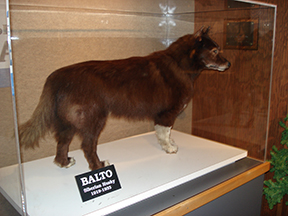There’s a little post-it stuck in my copy of The Black Dahila on the page where Bleichert first goes to the Sprague mansion and gets introduced to Balto. It says, “people who are not like us.”
 What kind of a person decides to shoot the family pet and have it stuffed in order to commemorate an occasion? And what does it say about the family? A different set of values, a different set of standards for behavior – that they’re in a position to do what they want and get away with it. Class differences came up before, in Mildred Pierce and Strangers on a Train, but this seems to be on a whole different level. Then again, everything about this book is on a whole different level.
What kind of a person decides to shoot the family pet and have it stuffed in order to commemorate an occasion? And what does it say about the family? A different set of values, a different set of standards for behavior – that they’re in a position to do what they want and get away with it. Class differences came up before, in Mildred Pierce and Strangers on a Train, but this seems to be on a whole different level. Then again, everything about this book is on a whole different level.
When dog-shooter Emmett starts to tell the story of Balto, some of the family react like they don’t want to hear it. I found it interesting that he referred to his birthplace, Aberdeen, as a “dead dog town.” Maybe he didn’t like the town, but I guess he liked the other part. Later in the dinner-table conversation, as mother Ramona starts telling her bit, Ellroy uses an unusual choice of words:
The woman’s out-of-kilter face congealed around the words…
“Congeal” means to solidify, take shape or coalesce. It was implied earlier that she was intoxicated on something other than alcohol, so the phrase is telling us that she becoming focused and attentive, but it also makes us think of blood (not that there isn’t blood on every other page in the book). In hindsight, this whole little scene ends up being the source of many clues.
 If I paid more attention to Disney films, I might have known that there really was a dog named Balto. Instead I googled the name, just to see what would come up. Not only was Balto a real animal, but he’s also really stuffed, and on display at the Cleveland Museum of Natural History.
If I paid more attention to Disney films, I might have known that there really was a dog named Balto. Instead I googled the name, just to see what would come up. Not only was Balto a real animal, but he’s also really stuffed, and on display at the Cleveland Museum of Natural History.


There’s also a statue of him in Central Park! Although I have to say that I enjoy the real life Balto more than the story in our book. The whole interaction was very peculiar to me, from the sister’s caricature to the mother’s comment of Maddie’s “male whores”; it seems like they each know of the dirty doings in the family but choose to ignore it until someone gets too sloppy. Why would that be? My only guess would be the prestige. On the whole, I found the family intriguing since it is very different from mine and also sort of seems unreal, however probable I know it would be for there this to be realistic.
This prompted me to peruse about half of The Drowning Pool – 133 pages or so – to see how many similes I could count. (I’m using the Vintage Crime Black Lizard edition from May 1996). I counted thirty four and no doubt missed a few. I haven’t done the legwork, but I think some of the later books might have a slightly higher ratio. That’s a lot, but in any case I would argue that many of Macdonald’s similes are so strong that they infinitely enrich the work. Not only that – they are so strong that they put many “serious” writers of fiction to shame.
http://postmoderndeconstructionmadhouse.blogspot.com/2014/11/ross-macdonald-drowning-pool.html#.VHQTZtKUeRZ